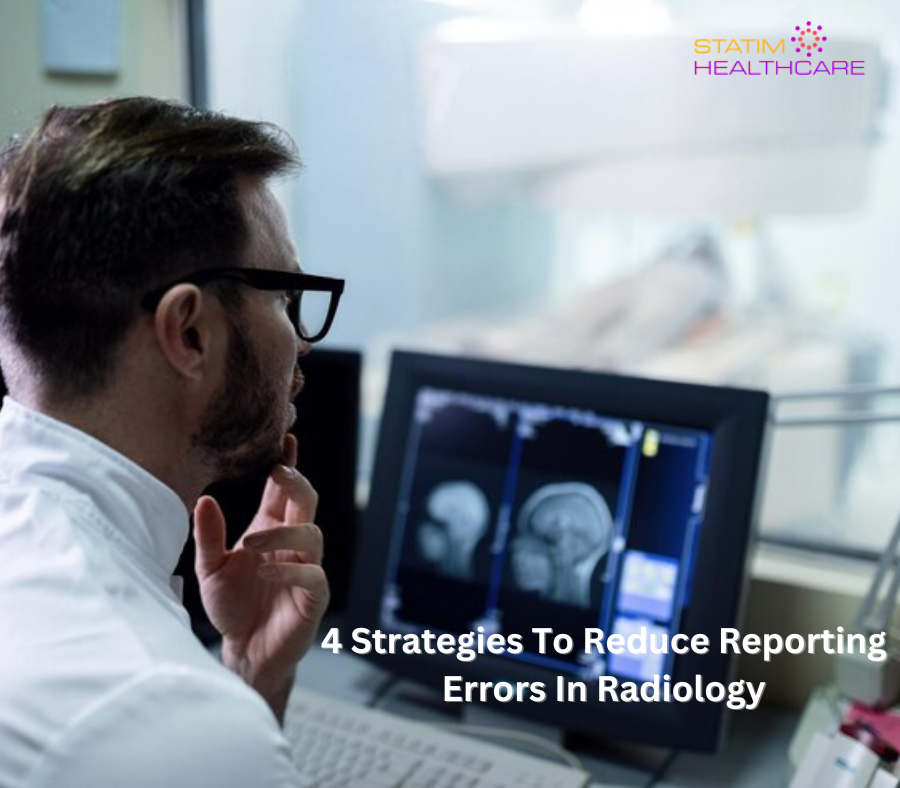In the dynamic field of medical imaging radiology, accuracy and precision are paramount. Reporting errors can lead to misdiagnosis, delays in treatment, and unnecessary procedures. To ensure the highest quality of patient care, it is imperative for healthcare providers to employ strategies aimed at minimizing reporting errors. In this blog post, we’ll explore four effective strategies that can significantly reduce reporting errors in radiology.
1. Improving Report Writing
Sometimes, even though we interpret imaging studies correctly, our written report might not express our meaning clearly. From the patient’s perspective, the same outcomes might transpire if a relevant abnormality is discovered but a potential diagnosis is missed, or if significant findings are discovered but inadequately communicated in a badly prepared report. If the referrer finds it difficult to understand what is most important in our verbose, rambling, and incomprehensible reports, we have not communicated properly and are equally guilty of “error” as if we had forgotten to provide the important information.
In fact, a general breakdown in communication was the cause of sixty percent of lawsuits brought against radiologists in the United States; specifically, sixty percent of these cases involved the failure to appropriately stress an urgent or unexpected aberrant finding.
It is advised to carefully review your earlier reports, or have a trustworthy colleague do so. Examine reports carefully, paying particular attention to the structure, choice of words, and overall layout. Are there any grammatical or punctuation mistakes? Have you transcribed something incorrectly using speech recognition software, leading others to interpret you differently?
2. Outsource Radiology Services to Experts
Outsourcing radiology services to specialized providers marks a strategic pivot that can redefine the landscape of diagnostic accuracy. The decision to outsource radiology services becomes a pivotal game-changer, particularly in the pursuit of minimizing reporting errors and optimizing the overall efficiency of healthcare operations.
Established outsourcing partners bring to the table a wealth of invaluable experience, fortified by a dedicated team of seasoned radiologists. This reservoir of expertise is complemented by access to the latest technologies, creating a synergy that significantly raises the bar for reporting accuracy. The cumulative effect is a paradigm shift towards more precise and timely diagnostic reports, a boon that reverberates positively across the entire spectrum of healthcare providers and their discerning patients.
As healthcare providers navigate the complexities of modern diagnostics, the decision to outsource, particularly to a trusted partner like Statim Healthcare, becomes not just a strategic move but a transformative journey towards a future where accuracy, efficiency, and patient-centric care converge seamlessly. With Statim Healthcare, precision in diagnostics is not just a goal; it’s a commitment to redefining the standards of excellence in radiology services.
3. Implement Stringent Quality Assurance Protocols
In the intricate landscape of radiology, the implementation of stringent quality assurance protocols stands out as a fundamental and indispensable strategy aimed at curbing reporting errors. This multifaceted approach involves the meticulous integration of checks and balances, encompassing a thorough examination of image quality, scrupulous validation of patient information accuracy, and unwavering adherence to established reporting guidelines.
These protocols serve as a steadfast fortress, ensuring that every radiological report meets the highest standards of precision and reliability. By placing a premium on the quality assurance process, radiology practices embark on a journey of continuous improvement, aligning their services with the paramount goal of delivering accurate and trustworthy diagnostic information.
This strategic imperative goes beyond a mere procedural checklist; it is a commitment to the foundational principles of accuracy and excellence in radiological reporting. As radiology professionals navigate the evolving landscape of healthcare, the implementation of stringent quality assurance protocols becomes not just a strategy but a cornerstone, ensuring that every diagnosis is underpinned by the highest standards of quality and integrity.
4. Leverage Collaborative Platforms
Effective communication and collaboration are indispensable in radiology reporting. Implementing collaborative platforms that facilitate seamless interaction between radiologists, referring physicians, and other healthcare professionals can lead to improved reporting accuracy. These platforms allow for the exchange of insights, clarification of doubts, and collective decision-making, all of which contribute to more precise diagnoses and treatment plans.
Reducing reporting errors in radiology is a critical endeavor that directly impacts patient outcomes. By adopting advanced radiology services, outsourcing to experienced providers, implementing stringent quality assurance protocols, and leveraging collaborative platforms, healthcare providers can significantly enhance the accuracy and reliability of their radiology reports. These strategies not only elevate the standard of care but also contribute to a more efficient and effective healthcare system.
At Statim Healthcare, we are committed to providing advance radiology services in USA. Our dedicated team of radiologists and state-of-the-art technology ensure the highest quality of reporting. To learn more about our medical imaging radiology solutions, visit our website.

